The story of Military Dog Tags spans millennia, and is fascinating to see how keeping our silent heroes accounted for during war times was first a priority, to later fade away only to return out of a basic human desire of being known, even in death, and not to become one of (too many) unknown soldiers.
What makes an army? The number of its soldiers? The thirst of its leaders or their pathos and charisma . As far back as 2000 BC the Xia Dynasty of China kept a 12 000 men army, the ancient Egypt saw a 100 000 men army during the reign of Ramesses II, the next massive army was that of the Persians under Cyrus the Great, with half a million men, equaled in number only by Mauryan Empire of India around 300 BCE.
Yet, did they mattered, the warriors? Were they seen an human beings, as individuals with dreams and aspirations, or as mere soldiers, the parts of a whole? Who missed them when they were gone, left to fertilize a foreign land? Who cried and uttered their names one last time? Who knew each one of them by their name?
“A mother, a daughter, a sister, a wife
Patricia Furstenberg
Wrote his name, carved it in wood
To remind him their love,
To keep him safe from death
A spell of love
The first ever dog tag.“
The first dog tags we know of in history belonged to the Spartans who wrote their names on sticks tied to their left wrists – because the left arm was holding the shield when in battle and the shield was a precious family heirloom. Spartans were bot only literate, but admired for their intellectual culture and poetry.
Could they have looked like these?

They might have looked fearless, the Spartans, in their crimson tunics and battered shields with the letter lambda painted on, and long hair – which they considered the symbol of a free man.
It is of no surprise that Roman legionaries also carried dog tags. But so did the poor Roman slaves… Less personalized than those of the Spartans, the Roman dog tags were received by each soldier on the moment of joining he Roman legion, the Roman Army Recruits, and were called signaculum, the seal. A signaculum, made of lead, carried the soldier’s name, “Unit” of assignment and, in some cases, home record etched on the front as well as a stamp to authenticate it, on the reverse. In the beginning the signaculum was kept in a small leather or cloth pouch and worn around the neck.



Until the permanent Soldier’s Mark was instated for Roman legionaries, a brand imprinted on the hands of the soldiers with a hot iron, possibly to discourage desertion, but only after he was proved fit for service. A tattoo, if you please.
A Roman slave pendant tag
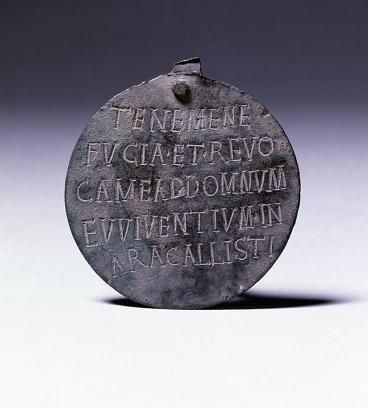
It was hanging from a ring, meant to be worn around the slave’s neck and made of iron and bronze.
“TENEMENE. FVGIA ET REVO. CAMEADDOMNVM. EVVIVENTIVM IN. ARACALLISTI“
“Tene me ne fugia[m] et revoca me ad dom[i]nu[m] meu [m] Viventium in ar[e]a Callisti”
~Translating to (if my Latin serves me well)~
Hold me lest I flee and return me to my master Viventius in the area of Callistus.
Luckily, this custom was later abolished by the relaxation introduced by a long peace.
I couldn’t find any records or mentions of any form of identification for soldiers that fought in Europe or elsewhere for the next fifteen hundred years or so…
I thought of the Janissaries, this incredible heroes of the Ottoman Empire that tormented southeastern Europe, Northern Africa and Western Asia for over six centuries, between the 14th and early 20th centuries… But Janissaries, despite their military status and recognizable hat (that tall bork fitted a stunning jeweled ornament in the middle of the forehead), were an army of slaves to the Ottoman Sultan. Their identity didn’t matter, only their force through training and numbers…
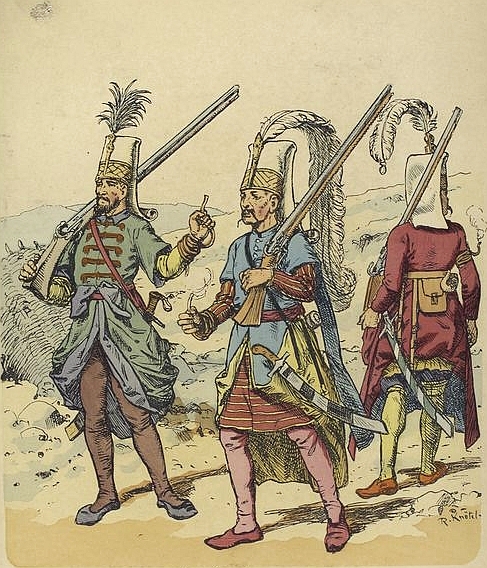
It was only in 1712 France that soldiers were recorded again, and issued a cartouche (cartouche de congé or feuilles de rutes) to prove their legal leave… but nothing about an identification tags.
This lack of identification tags for soldiers comes at no surprise if we consider that in 16th and 17th century France personal identity (of a civilian) was based on interpersonal relations, shared experiences and social bonds between the members of a community, from family to the parish and so on. Thus, a stranger leaving this cocoon, this sphere of interpersonal relations became unknown, no longer recognized – and identified.
It was in 1792 when births and deaths in France had to be legally registered and passports were issued for every traveler during the French revolution. Although some primitive forms of passport did exist, being inherited from the Middle Ages and being more of a privilege than a form of identification…
We do know that Napoleon mustered an army of 2.5 million people at the beginning of the 19th century…. nearly 400 000 were killed in action not counting the invasion of Russia where around one million French and allied soldiers perished.
Across the Pond, someone was killing President Thomas Jefferson’s sheep. His neighbor’s dogs. So the President wrote the first dog licensing law for his home state of Virginia wishing to identify the owners of the naughty dogs owners and make them pay for his loss. By the 1850’s most cities had such laws requiring dog owners to attach a collar with their name and license number around their doggo’s neck.
Because no one expected the American Civil War to last so long, 1861 – 1865, most soldiers marched off to fight in a wide variety of uniforms, most of them homemade. Their own clothes. Later the uniforms became blue for Unions, Bluebellies, and light brownish for the Confederates, Butternuts.
It took more than three years of bloody fighting for everyone to understand how dangerous the coming battle would be.
Do you remember the ‘sash’ Scarlett made for Ashley? No dog tags, still… made to tell him apart.


Yet no soldier’s uniform of the American Civil War included a set of dog tags, although in May 1962 John Kennedy from New York proposed that each Union soldier is issued with an ID tag. And the soldiers cared that, when they die, their families back home know to mourn them. There is a sea of graves with headstones marked ‘Unknown Soldier’. So soon, as soon as the men saw that this war will never end, the soldiers (perhaps their wives too, their mothers, sisters, sweethearts, from South and from the North) began to sew their names on the uniform, before leaving for battle, before kissing them good bye, hugging them one last time, before praying together for a happy reunion. One more…
Those in a hurry just wrote their name on a piece of paper or a handkerchief, pinned it to their blouses and hoped they won’t bleed on it, when wounded. Some even carved their names on small wooden discs , pierced a hole through it and hung it from their neck with a piece of string. Others stenciled identification on their knapsacks or scratched it in the soft lead backing of their army belt buckle. Most of them were 16 – 23 years old.
Still, about 50% of soldiers killed in action were positively identified.
Eventually, merchants saw a booming business and began producing metal disks shaped to suggest a branch of service. These were soon called name discs or soldier pins. Some sold soldier pins made of silver or gold and etched with the soldier’s name and unit. But not everyone could afford one so most soldiers made their own ID tags by grinding off one side of a coin and then etching their names on it.
Cheaper, machine-stamped tags appeared, made of brass or lead with a hole. They had an eagle or shield and a motivational phrase such as “War for the Union” or “Liberty, Union, and Equality” on one side. The other side showed the soldier’s name and unit, and sometimes a list of battles in which he had participated. By the 1890s, the U.S. Army and Navy began experimenting with issuing metal identification tags to recruits.
It didn’t took long until the wooden and metal discs used for dogs were referred to as dog tags and that name carried over to their human counterparts.
But such dog tags were also provided to the Chinese soldiers during the Taiping revolt, 1851 – 1866, when both the Chinese Imperial Army soldiers and the Taiping rebels wearing a uniform wore a wooden dog tag at the belt with their name, age, birthplace, unit, and date of enlistment inscribed.
1866 Europe, the Prussian soldiers began wearing dog tags during the Austro – Prussian War but on a volunteer basis only as many considered them a bad omen. Sad, as in the aftermath of the decisive Battle of Königgrätz (Sadowa), when the Kingdom of Prussia defeated the Austrian Empire which led to the German unification, the Little Germany (Germany without Austria), out of 8900 Prussian casualties only 429 of them could be identified. It was three years later the Recognitionsmarke, recognition mark, became obligatory, but the soldier called them Hundermarken, since they looked like ID tags used for the canines of Berlin… Story goes that King Wilhelm flew into a rage about the common naming of the tag saying that his soldiers are not dogs – so the nickname was forbidden in the following years…which only encouraged it’s use by the soldiers.
You can see below an Austro – Hungarian Empire‘s Officer Legitimization Case, a pre-design of a dog tag. On the obverse the case is engraved with the Imperial Cypher of King Frans Joseph I of Austria, while on the reverse is the Austro – Hungarian Coat of arms (double headed crowned eagle). The case opened and inside were included personal ID, service records, list of decorations awarded.
Meanwhile, in 1907 the British Army replaced the identity cards with aluminum discs, each soldier receiving two. An octagonal green tag was attached to a cord around the neck, intended to remain on the body for future identification. The second tag, a red circular disc, was suspended from the first and could be removed to record the soldier’s death. The British forces serving in Australia, Canada, and New Zealand received similar dog tags during the Great War, exception making the sailors who preferred an ID bracelet.
It was in 1906 when the U.S. government decided by a general order that a circular aluminum disc be worn as an identification tag by all soldiers, and by 1913 all military service members were required to wear such an identification disc. The aluminum disc was the size of a silver half dollar and imprinted with the name, rank, company, regiment or corps, and worn suspended around the neck.

When U.S. entered World War I (1914-1918) in 1917 all its service members, killed or wounded, were therefor identified and accounted for. It was now when military service members began wearing two such identification tags hand-stamped with their name, rank, serial number, unit and religion. One tag was meant to remain attached to the body of the deceased while the other would mark the coffin or the grave site, be it home or away.
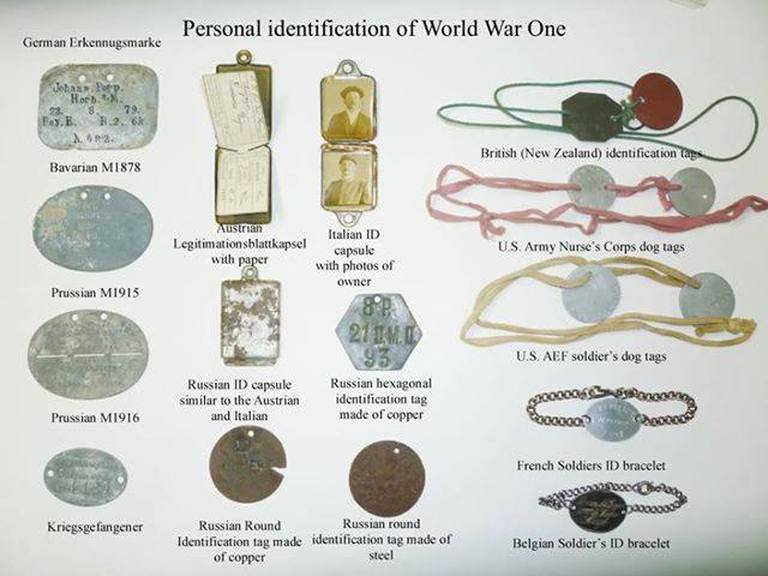
Canadian, USA, British WW1 dog tags and a custom stamping set:




At the same time back in Europe the French soldiers were fitted with a bracelet displaying a metal disk engraved with the their name, rank and other pertinent formation. And here’s a Scottish one:


In Russia, after the outbreak of hostilities in 1914 and the necessity to increase the newly mobilized force exponentially, up to 75% of the Russian troops entered WW1 with no form of personal identification…
Below, a Russian tag from 1902, a 1909 wooden cylinder used to protect a piece of paper with the soldier’s details (although it was also used to store matches), and a 1917 dog tag:



Of course, I should show you some Romanian dog tags from WW1 and WW2:



During WWII, 1939-1945, most dog tags used looked like the ones we’ve seen often – at least in the movies: rectangular shaped with rounded ends and machine stamped. First made of brass, then from a corrosion-resistant alloy, nickel – copper, and eventually from stainless steel.

Below: a British RAF dog tag of a soldier named Astman and Australian dog tags (notice the rubber rim meant to silence them)


Still, the human’s wars were not over…
Two Finish dog tags, first one from the Winter War (the war between the Soviet Union and Finland, 30 Nov 1939 – 13 Mar 1940), the second one is modern, it has the letters SF, Suomi Finland, stamped within a tower.


During the 1950s some rules regarding dog tags changed, one identification tag was placed on a long chain, while the second was hung on a shorter chain. In case of death the identification tag on the shorter chain was meant to be placed around the toe of the deceased, toe tag. The other dog tag was meant to remain with the deceased or used to report back the name of the deceased soldier.
For those who experienced the Communist Block, Eastern Block, and the Cold War this army pass book for a Corporal in die NVA – Die Nationale Volksarmee der DDR (The National People’s Army) will bring back a wave of memories. Next DDR and Germany dog tags (notice the differences between the two):


During the long Vietnam War, 1955-1975, the soldiers, exasperated by the noise the dog tags made while banging each other, something that endangered their safety during the long, humid moths of unending battles and hiding in the Asian jungles… began taping the dog tags together. Thus rubber covers came in use so the tags remain silent. But the Vietnam War was a different war and bodies often became dismembered to an extent they were often unidentifiable… so the soldiers would often wear one dog tag in one boot, tied with the bootlace in case in might, just might help with the recovery of their remains.
I discovered two P.O.W. (Prisoner Of War) dog tags, fashioned by prisoners while locked away, awaiting. What? … While hoping, thinking of what they left behind, of what they have back home (their only wealth), dreaming, not as in hoping, but as night visions, the only way they could escape an uncertain present built out of nightmares. I believe these dog tags are the most valuable ones, both a letter and a will, a cry for life and a farewell.
Below is a dog tag fashioned by a prisoner of war, P.O.W., held captive perhaps somewhere in Asia (by the deign of the tower) during WW2. Notice the machine gun in the tower and the barbed wire fence.
And a dog tag made by a P.O.W. during the Boer War with a medallion made from a horn. You cab read ‘Boer Camp’ inscribed at the bottom.



This is the story of Military Dog Tags, coming such a long way from a name engraved on a stick of wood to stainless steel plates holding military and medical records and even microchips and, most importantly, the soldier’s name.
Below: dog tags from the Iraq/Afghanistan Dog Tag Memorial at the Museum of the Forgotten Warrior outside of Beale Air Force Base, California. The memorial honors all the men and women killed during the Iraq and Afghanistan Wars as of October 30, 2011, containing 6296 individual dog tags. (U.S. Air Force photo by Staff Sgt. Jonathan Fowler)-source.


A dog tag,
A soldier’s surviving touch,
His last handshake,
His last word,
His last breath
Spared for those back home.
(Patricia Furstenberg)


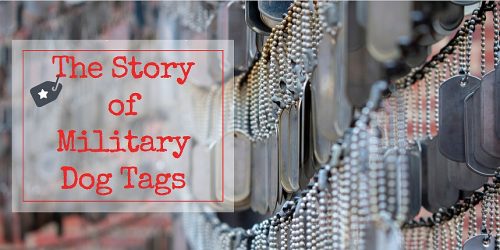
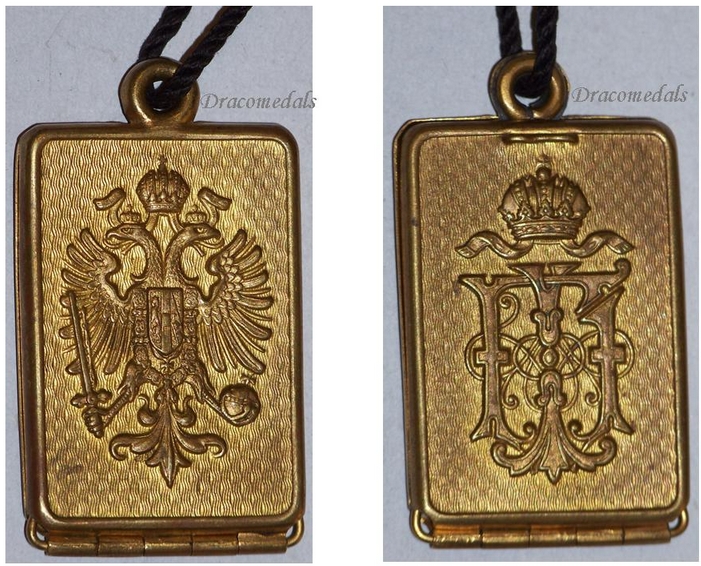

This was a fascinating post. I had no idea dog tags had been around so long. Some of the photos are sobering. It’s sad to think of people dying in war.
I do appreciate your thoughts, Priscilla.
Perhaps dog tags are a symbol of war that’s often overlooked. Once they entered the fashion they’ve been stripped of their intended meaning. And purpose.
Thank you for visiting 🙂
Have a wonderful weekend. Surely you will be reading. Some more 🙂
A very interesting article, Pat. Just the words “dog tags” makes me shiver. Yet, I did not really know anything about the history of these words. “Being known, even in death” speaks volumes. Numbers, and statistics are exceptionally sad when referring to lives. To people.
Powerful words, tears brimming, “Who cried and uttered their names one last time?”
Interesting about the link to “the naughty dogs owners” and actual dog tags. And then, the “booming business.” Powerful words again, “…both a letter and a will, a cry for life and a farewell.”
Exceptional amount of research went into this post, Pat. A great deal of fascinating information. I appreciate you sharing.
Ah, Erica, happy to read your thoughts.
From a distance, soldiers look so brave outside their human core.
None wants to be forgotten in death, at least few are those who don’t care. It must be one of our most silenced fears.
Well, the research kind of went through my pores, but then I always bury myself in it and challenge myself to swim to the other shore 😉
Thank you so much for reading and commenting 🙂
Have a blessed weekend!
Great post Pat.
Thanking you kindly, David 🙂
Muy interesante. Es un tema que desconocía.
Thank you, Julio. So glad you found it interesting 🙂
I had no idea that there was such a long history of dog tags. Thanks for the fascinating post, Pat. 🙂
Thank you for visiting, Diana.
I, too, discovered their very long history the hard way – initially I thought it will be fun post to write. But I’m not one to shy away from a mountain of research, on the contrary 😉
Have a blessed Sunday!
Outstanding research, and so well written. Thank you for posting.
Thank you so much, Mike.
Your positive comment is highly appreciated 🙂
Hi Pat,
A most interesting story, thanks for sharing it.
Best Wishes
Kevin
Thank you so much, Kevin!
Have a lovely week further.
Thank you 🙂
A fascinating history, Pat. I thought dog tags were a modern invention, obviously I was wrong.
It took me by surprise too, Mark.
It is humbling to learn how priceless life (and the memory of it) always has been.